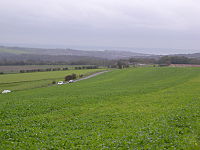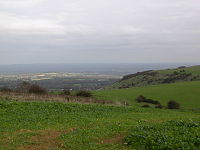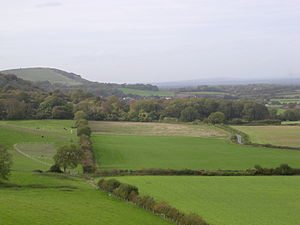Ditchling Beacon
| Ditchling Beacon | |||
| Sussex | |||
|---|---|---|---|
Northward view from the summit of Ditchling Beacon | |||
| Range: | South Downs | ||
| Summit: | 814 feet TQ331130 50°54’7"N, 0°6’25"W | ||
Ditchling Beacon is a hill within the South Downs, in Sussex, overlooking Brighton and the coastal villages. It is the third-highest point on the South Downs, behind Butser Hill (886 feet) and Crown Tegleaze (830 feet).
This is a large chalk hill with a particularly steep northern face, covered with open grassland and sheep-grazing areas. At the foot of its north slope is the village of Ditchling, from which the hill is named, and to the south-west is the City of Brighton.

A road runs from Ditchling up and across the northern face and down into the northern suburbs of Brighton, and there are car parks at the summit and the northern base.
Various charity, sporting and other events which are run regularly between London and Brighton incorporate this steep road as a challenging part of their route. It was also featured as a climb on the first of two days' racing in Britain in the 1994 Tour de France.[1] The Tour organisers gave Ditchling Beacon a climb category of 4. Twenty years later it was included as part of the route of the seventh stage of the 2014 Tour of Britain from Camberley to Brighton.[2]
Location and archaeology


The hill dominates adjoining parts of the South Downs ridge, and particularly the much lower ground to the north (where Sussex's pretty inland villages nestle between the Downs and the Weald). This hill would have represented in past ages an excellent position for defensive purposes, and is known to be the site of an early Iron Age hill fort. A single defensive bank and ditch enclosed an area of approximately 13.6 acres.[3] Relatively little excavation of the fort has been carried out, however, and the existence of dew ponds, paths and tracks, as well as regular ploughing activity over the years, reduces the likelihood of any significant discoveries in the future.
Access
The only road access to the summit is the steep and narrow Beacon Road, which runs from the centre of Ditchling village and takes the name Ditchling Road once the summit is reached and the descent into Brighton commences. Beacon Road connects with the B2116, which connects several villages close to the foot of the South Downs with the outskirts of Lewes. Underhill Lane, a minor road directly at the foot of the Downs, crosses Beacon Road adjacent to the car park. The road then begins a steep ascent of the northern slope, from eight hundred feet to three hundred feet above sea level in just over a mile writhing from side to side around a number of sharp bends.
At the summit is a large car park, owned and operated by the National Trust (which also owns and manages approximately four acres of land on the hill). Controversy occurred in November 2005 when a £2.00 charge for parking at this car park (and five others at National Trust-owned sites on the South Downs) was introduced.
From this point, Ditchling Road descends through open downland for approximately two and a half miles until the edge of the Brighton built-up area is reached at Hollingbury. The road crosses the A27 Brighton Bypass and continues as a busy suburban road for more than three miles into the centre of Brighton.
A footpath and bridleway runs across the ridge from east to west, taking in the summit and forms part of the South Downs Way. Various footpaths and bridleways run down both the northern and southern slopes towards Brighton, Ditchling and other nearby villages such as Westmeston and Clayton.
Access by rail can be achieved from Hassocks, from where a well-used path runs alongside the line to Clayton, at the western end of Underhill Lane. From here, access can be gained to several paths and bridleways leading up to Ditchling Beacon itself, or points slightly to the west on the South Downs Way.
Flora and fauna
A wide variety of plants can be found on Ditchling Beacon, especially during the summer. Flowers and herbs suited to chalk grassland, such as marjoram, thyme and certain types of orchid (notably the common spotted orchid), are often reported. (Some parts of the surrounding land are merely scrubland, however.) Butterflies are common; a notable example is the Chalkhill Blue, which is particularly well suited to uncultivated chalk downland areas. Some parts of the hill and the surrounding fields (particularly Ditchling Down, a large open area near the base of the northern face, close to the Beacon Road car park) are used for the grazing of sheep.
Geodesy
Ditchling Beacon was the origin (meridian) of the 6 inch and 1:2500 Ordnance Survey maps of Sussex.[4]
Outside links
| ("Wikimedia Commons" has material about Ditchling Beacon) |
- "All About Sussex" - Ditchling Beacon
- Flora and fauna information, and maps
- Hill fort information
- National Trust information
- BBC News report on charges at the main car park - November 2005
References
- ↑ 'Cycling / Tour de France: Hills and sprints set to attract crowds': Martin Whitfield in The Independent ('Cycling') 4 July 1994
- ↑ 'Tour of Britain 2014 stage seven preview' in Cycling Weekly 2 September 2014
- ↑ Sussex ARchaeology
- ↑ Meridians - The Charles Close Society
